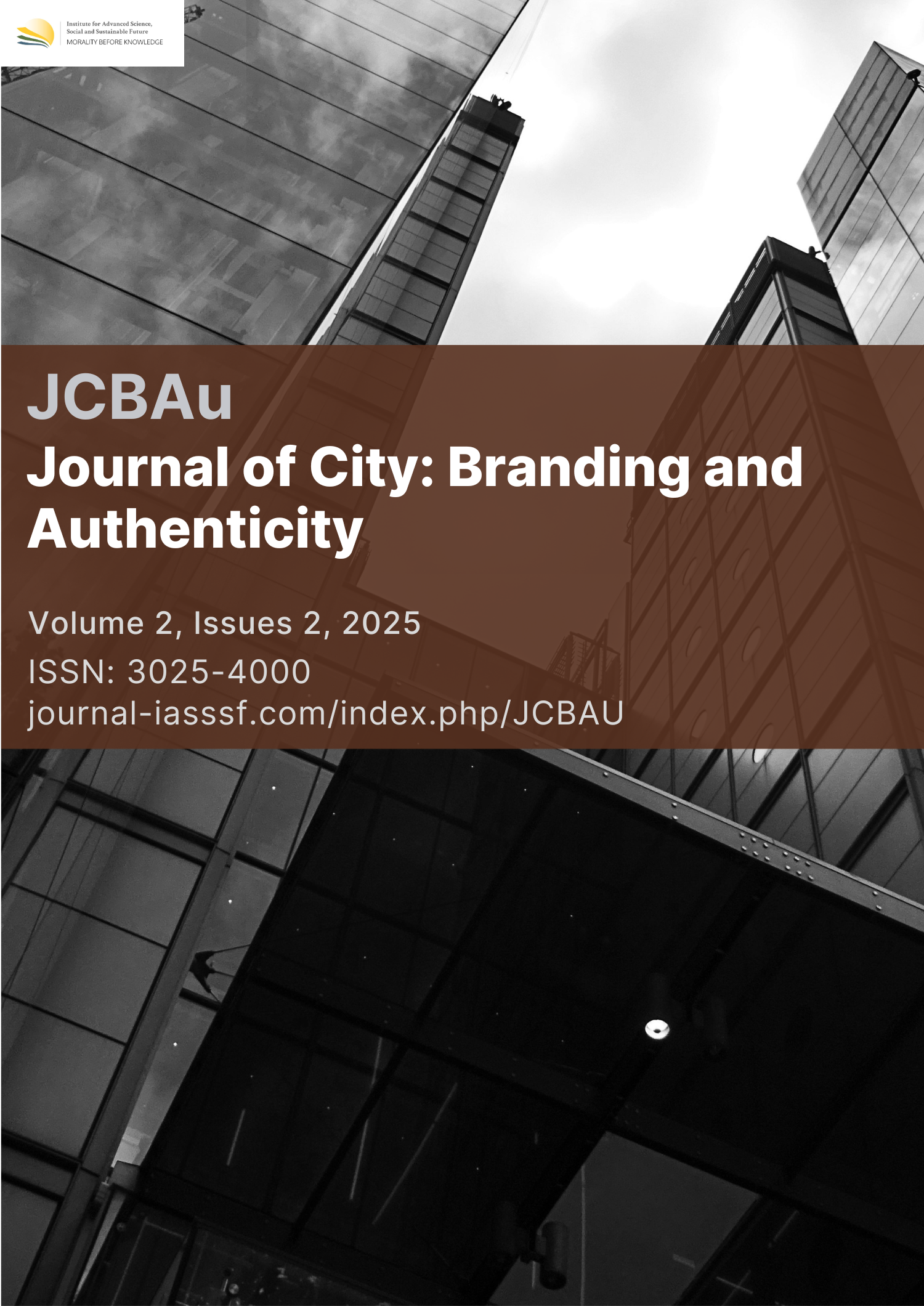The Authenticity redefined: A new paradigm for sustainable heritage in yangon’s iconic governor's residence
DOI:
https://doi.org/10.61511/jcbau.v2i2.2025.1423Keywords:
adaptive reuse, conservation , Governor's Residence, sustainable heritage, YangonAbstract
Background: The Governor's Residence in Yangon, Myanmar, is a historical icon embodying the city's colonial past and architectural heritage. As urbanization and environmental challenges mount, redefining such heritage sites through sustainable practices becomes imperative. Methods: This study employed a qualitative research approach, integrating historical analysis, field observations, and stakeholder interviews. Data were gathered from archival records, peer-reviewed literature, and architectural site visits. Comparative analysis with similar heritage conservation projects in Southeast Asia provided additional insights. Findings: By employing eco-conscious architectural restoration, integrating renewable energy systems, and fostering community engagement, the residence can maintain its historical integrity while contributing to environmental stewardship. Additionally, adaptive reuse and educational initiatives can ensure its cultural and social relevance in the 21st century. Conclusion: The proposed approach underscores the importance of balancing historical preservation with sustainable modernization, offering a replicable framework for a heritage site. Novelty/Originality of the Study: This study introduces a novel approach to heritage conservation, combining eco-conscious restoration, renewable energy integration, and community engagement to transform a colonial-era structure into a sustainable cultural landmark. The findings present a replicable model for other historical sites facing similar urbanization and environmental challenges.
References
Avrami, E., Mason, R., & de la Torre, M. (2000). Values and heritage conservation. The Getty Conservation Institute. https://www.getty.edu/conservation/publications_resources/pdf_publications/pdf/valuesrpt.pdf
Bandarin, A., & van Oers, R. (2012). The historic urban landscape: Managing heritage in an urban century. Routledge.
Bassett, A. K. (2017). Difficult history: Saving Yangon from colonial nostalgia. University of Yangon Press. https://dspace.mit.edu/handle/1721.1/111371
Belmond Governor’s Residence. (n.d.). Luxury colonial-style hotel in Yangon. https://belmond-governors-residence.hotelinyangon.net/en/
Bouchet, C. M. (2014). Yangon’s cultural and historical narratives: The significance of the Governor's Residence. The New York Times.
Bullen, P. A., & Love, P. E. D. (2011). Adaptive reuse of heritage buildings. Structural Survey, 29(5), 411–421. https://doi.org/10.1108/02630801111182439
Champion, E. (2015). Critical gaming: Interactive history and virtual heritage. Routledge.
Chang, T. C. (2016). Heritage and cultural preservation in Southeast Asia. Asian Journal of Social Science, 44(2), 136–159. https://doi.org/10.1163/15685314-04402003
Falk, J. H., & Dierking, L. D. (2016). The museum experience revisited. Routledge. https://doi.org/10.4324/9781315417851
Governor's Residence. (n.d.). Belmond Governor's Residence official website. https://governorsresidence.com/
Heeckt, C., Satterthwaite, D., & Tacoli, C. (2017). Urban development in Yangon: Historical structures and planning strategies. International Growth Centre.
Hellmann-Rajanayagam, D. (2020). Yangon's transformation: Colonial and postcolonial landmarks. University of Yangon Press.
Hirano, K., & Yokohari, M. (2018). Historical processes of urban form and land-use change at Shwedagon Pagoda’s surrounding area in Yangon, Myanmar. International Planning History Society Proceedings, 18(1), 923-934. https://doi.org/10.7480/iphs.2018.1.2740
International Council on Monuments and Sites (ICOMOS). (1964). The Venice Charter for the Conservation and Restoration of Monuments and Sites. International Council on Monuments and Sites (ICOMOS). https://www.icomos.org/images/DOCUMENTS/Charters/venice_e.pdf
International Council on Monuments and Sites (ICOMOS). (2023). Tourism and heritage conservation: Best practices for sustainable management. International Council on Monuments and Sites (ICOMOS). https://www.icomos.org/actualite/the-new-icomos-international-charter-for-cultural-heritage-tourism-supports-a-more-responsible-and-sustainable-tourism-management/
International Energy Agency (IEA). (2020). Energy efficiency 2020. International Energy Agency (IEA). https://www.iea.org/reports/energy-efficiency-2020
Licciardi, G., & Amirtahmasebi, R. (2012). The economics of uniqueness: Investing in historic city cores and cultural heritage assets for sustainable development. World Bank Publications. https://documents1.worldbank.org/curated/en/727651468340186831/pdf/730720PUB0EPI001200pub0date01001012.pdf
Logan, W. S. (2002). The disappearing Asian city: Protecting Asia’s urban heritage in a globalizing world. Oxford University Press. https://digitalcommons.calpoly.edu/cgi/viewcontent.cgi?referer=&httpsredir=1&article=1033&context=crp_fac
MacKenzie, J. M. (2020). Colonial cities and architecture: The case of Rangoon and the Governor's Residence. In Imperial Architecture and Urbanism (pp. 102–125). Oxford University Press.
Markham, A., Osipova, E., Lafrenz Samuels, K., & Caldas, A. (2016). World Heritage and tourism in a changing climate. UNESCO Publishing.
Myo, H., & Tun, A. (2022). Urbanization and heritage conservation in Yangon: Challenges and strategies. Journal of Southeast Asian Studies, 53(2), 112–130. https://doi.org/10.1017/S0022463422000158
Pendlebury, J. (2013). Conservation values, the authorised heritage discourse and the conservation-planning assemblage. International Journal of Heritage Studies, 19(7), 709–727. https://doi.org/10.1080/13527258.2012.700282
Pendlebury, J., Short, M., & While, A. (2009). Urban World Heritage Sites and the problem of authenticity. Cities, 26(6), 349–358. https://doi.org/10.1016/j.cities.2009.09.003
Plevoets, B., & Van Cleempoel, K. (2011). Adaptive reuse as a strategy towards conservation of cultural heritage: A literature review. International Journal of Architectural Heritage, 5(2), 123–148. https://doi.org/10.1080/15583058.2010.481553
Poulios, I. (2014). The past in the present: A living heritage approach. Ubiquity Press.
Sloan, J. (2007). Yangon’s exotic cultural and historical blend: The role of luxury properties like the Governor’s Residence. Lonely Planet Publications.
Smith, L. (2006). Uses of heritage. Routledge. https://doi.org/10.4324/9780203602263
Soini, K., & Birkeland, I. (2014). Exploring the scientific discourse on cultural sustainability. Geoforum, 51, 213–223. https://doi.org/10.1016/j.geoforum.2013.12.001
Stanley-Price, N. (2021). Historic buildings and adaptive reuse: Preserving authenticity in modern times. Routledge.
Stubbs, J. H. (2010). Time honored: A global view of architectural conservation. John Wiley & Sons.
Tunbridge, J. E., & Ashworth, G. J. (1996). Dissonant heritage: The management of the past as a resource in conflict. Wiley.
United Nations Educational, Scientific and Cultural Organization (UNESCO). (2011). Operational Guidelines for the Implementation of the World Heritage Convention. UNESCO Publishing. https://whc.unesco.org/archive/opguide12-en.pdf
United Nations Educational, Scientific and Cultural Organization (UNESCO). (2023). Climate change and cultural heritage: Risks and adaptation strategies in Southeast Asia. UNESCO Publishing. https://www.unesco.org/en/climate-change
Waterton, E., & Watson, S. (2015). The Palgrave handbook of contemporary heritage research. Palgrave Macmillan.
Winter, T. (2014). Beyond Eurocentrism? Heritage conservation and the politics of difference. International Journal of Heritage Studies, 20(2), 123–137. https://doi.org/10.1080/13527258.2012.736403
Yangon Guide. (n.d.). Governor's Residence Hotel. https://www.yangongui.de/governors-residence-hotel/
Yung, E. H. K., & Chan, E. H. W. (2012). Implementation challenges to the adaptive reuse of heritage buildings: Towards the goals of sustainable, low carbon cities. Habitat International, 36(3), 352–361. https://doi.org/10.1016/j.habitatint.2011.11.001
Downloads
Published
How to Cite
Issue
Section
Citation Check
License
Copyright (c) 2025 Theingi Aung

This work is licensed under a Creative Commons Attribution 4.0 International License.














